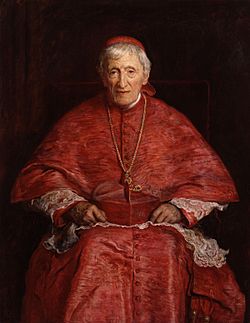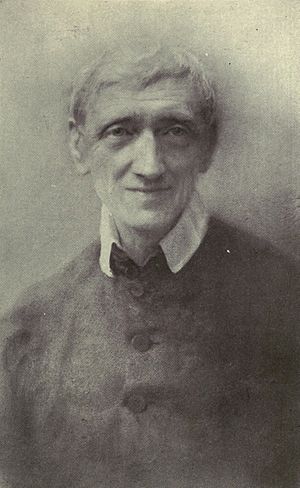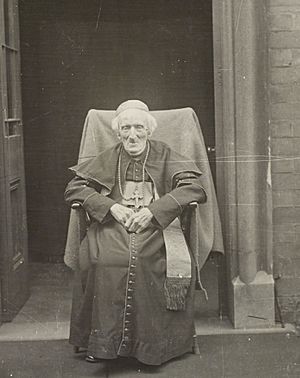John Henry Newman facts for kids
Quick facts for kids Saint John Henry Newman CO |
|
|---|---|
| Cardinal Deacon of San Giorgio in Velabro | |

Photograph by Herbert Rose Barraud, c. 1885
|
|
| Church | Catholic Church |
| Appointed | 15 May 1879 |
| Reign ended | 11 August 1890 |
| Predecessor | Tommaso Martinelli |
| Successor | Francis Aidan Gasquet |
| Other posts |
|
| Orders | |
| Ordination |
|
| Created Cardinal | 12 May 1879 |
| Rank | Cardinal deacon |
| Personal details | |
| Birth name | John Henry Newman |
| Born | 21 February 1801 London, England |
| Died | 11 August 1890 (aged 89) Edgbaston, Birmingham, England |
| Buried | Oratory Retreat Cemetery Rednal, Metropolitan Borough of Birmingham, West Midlands, England |
| Nationality | British |
| Denomination |
|
| Parents |
|
| Alma mater | Trinity College, Oxford |
| Motto | Cor ad cor loquitur ('Heart speaks unto heart') |
| Signature | |
| Coat of arms |  |
| Sainthood | |
| Feast day |
|
| Venerated in | |
| Beatified | 19 September 2010 Cofton Park, Birmingham, England by Pope Benedict XVI |
| Canonized | 13 October 2019 Saint Peter's Square, Vatican City by Pope Francis |
| Attributes | Cardinal's attire, Oratorian habit |
| Patronage | Personal Ordinariate of Our Lady of Walsingham; poets |
| Shrines | Birmingham Oratory |
John Henry Newman, (21 February 1801 – 11 August 1890) was a poet and theologian, first an Anglican priest and later a Catholic priest and cardinal, who was an important and controversial figure in the religious history of England in the 19th century. He was known nationally by the mid-1830s.
Contents
Early life and education
Newman was born on 21 February 1801 in the City of London, the eldest of a family of three sons and three daughters. His father, John Newman, was a banker with Ramsbottom, Newman and Company in Lombard Street. His mother, Jemima (née Fourdrinier), was descended from a notable family of Huguenot refugees in England, founded by the engraver, printer and stationer Paul Fourdrinier. Francis William Newman was a younger brother. His younger sister, Harriet Elizabeth, married Thomas Mozley, also prominent in the Oxford Movement. The family lived in Southampton Street (now Southampton Place) in Bloomsbury and bought a country retreat in Ham, near Richmond, in the early 1800s.
At the age of seven Newman was sent to Great Ealing School conducted by George Nicholas. There George Huxley, father of Thomas Henry Huxley, taught mathematics, and the classics teacher was Walter Mayers. Newman took no part in the casual school games. He was a great reader of the novels of Walter Scott, then in course of publication, and of Robert Southey. Aged 14, he read sceptical works by Thomas Paine, David Hume and perhaps Voltaire.
Newman's name was entered at Lincoln's Inn. He was, however, sent shortly to Trinity College, Oxford, where he studied widely. His anxiety to do well in the final schools produced the opposite result; he broke down in the examination, under Thomas Vowler Short, and so graduated as a BA "under the line" (with a lower second class honours in Classics, and having failed classification in the Mathematical Papers).
Desiring to remain in Oxford, Newman then took private pupils and read for a fellowship at Oriel College, then "the acknowledged centre of Oxford intellectualism". He was elected a fellow at Oriel on 12 April 1822. Edward Bouverie Pusey was elected a fellow of the same college in 1823.
Career
On 13 June 1824, Newman was made an Anglican deacon at Christ Church Cathedral, Oxford. Ten days later he preached his first sermon at Holy Trinity Church in Over Worton (near Banbury, Oxfordshire) while on a visit to his former teacher the Reverend Walter Mayers, who had been curate there since 1823. On Trinity Sunday, 29 May 1825, he was ordained a priest at Christ Church Cathedral by the Bishop of Oxford, Edward Legge. He became, at Pusey's suggestion, curate of St Clement's Church, Oxford. Here, for two years, he was engaged in parochial work and wrote articles on "Apollonius of Tyana", "Cicero" and "Miracles" for the Encyclopædia Metropolitana.
Originally an evangelical academic at the University of Oxford and priest in the Church of England, Newman became drawn to the high-church tradition of Anglicanism. He became one of the more notable leaders of the Oxford Movement, an influential and controversial grouping of Anglicans who wished to restore to the Church of England many Catholic beliefs and liturgical rituals from before the English Reformation. In this, the movement had some success. After publishing his controversial Tract 90 in 1841, Newman later wrote: "I was on my death-bed, as regards my membership with the Anglican Church." In 1845 Newman, joined by some but not all of his followers, officially left the Church of England and his teaching post at Oxford University and was received into the Catholic Church. He was quickly ordained as a priest and continued as an influential religious leader, based in Birmingham. In 1879, he was created a cardinal by Pope Leo XIII in recognition of his services to the cause of the Catholic Church in England.
In 1854, at the request of the Irish Catholic bishops, Newman went to Dublin as rector of the newly established Catholic University of Ireland, now University College Dublin. It was during this time that he founded the Literary and Historical Society. After four years, he retired. He published a volume of lectures entitled The Idea of a University, which explained his philosophy of education.
Newman was also a literary figure: his major writings include the Tracts for the Times (1833–1841), his autobiography Apologia Pro Vita Sua (1865–1866), the Grammar of Assent (1870), and the poem The Dream of Gerontius (1865), which was set to music in 1900 by Edward Elgar. He wrote the popular hymns "Lead, Kindly Light", "Firmly I believe, and truly", and "Praise to the Holiest in the Height" (the latter two taken from Gerontius).
Newman's beatification was proclaimed by Pope Benedict XVI on 19 September 2010 during his visit to the United Kingdom. His canonisation was officially approved by Pope Francis on 12 February 2019, and took place on 13 October 2019. He is the fifth saint of the City of London, after Thomas Becket (born in Cheapside), Thomas More (born on Milk Street), Edmund Campion (son of a London bookseller) and Polydore Plasden (of Fleet Street).
Later years and death
In 1878, Newman's old college elected him an honorary fellow, and he revisited Oxford after an interval of thirty-two years, on the same day Pope Pius IX died. Newman was elevated to the rank of cardinal in the consistory of 12 May 1879 by Pope Leo XIII, who assigned him the Deaconry of San Giorgio al Velabro.
After an illness, Newman returned to England and lived at the Birmingham Oratory until his death, making occasional visits to London and chiefly to his old friend R. W. Church, now Dean of St Paul's. As a cardinal, Newman published nothing beyond a preface to a work by Arthur Wollaston Hutton on the Anglican ministry (1879) and an article, "On the Inspiration of Scripture", in The Nineteenth Century (February 1884).
From the latter half of 1886, Newman's health began to fail. On 11 August 1890 he died of pneumonia at the Birmingham Oratory. Eight days later his body was buried alongside Ambrose St. John in the cemetery at Rednal Hill, Birmingham, at the country house of the oratory. At the time of his death he had been Protodeacon of the Holy Roman Church.
In accordance with his express wishes, Newman was buried in the grave of his lifelong friend Ambrose St. John. The pall over the coffin bore the motto that Newman adopted for use as a cardinal, Cor ad cor loquitur ("Heart speaks to heart"). Ambrose St. John had become a Roman Catholic at around the same time as Newman, and the two men have a joint memorial stone inscribed with the motto Newman had chosen, Ex umbris et imaginibus in veritatem ("Out of shadows and phantasms into the truth"), which Barry traces to Plato's allegory of the cave.
Remains
Newman's grave was opened on 2 October 2008, with the intention of moving any remains to a tomb inside Birmingham Oratory for their more convenient veneration as relics during Newman's consideration for sainthood; however, his wooden coffin was found to have disintegrated and no bones were found. A representative of the Fathers of the Birmingham Oratory alleged that this was because the coffin was wooden and the burial took place at a damp site. Contemporary sources show that the coffin was covered with a softer type of soil than the clay marl of the grave site. Forensic expert John Hunter, from the University of Birmingham, tested soil samples from near the grave and said that total disappearance of a body was unlikely over that timescale. He said that extreme conditions which could remove bone would also have removed the coffin handles, which were extant.
Tertiary education
Newman founded the independent school for boys Catholic University School, Dublin, and the Catholic University of Ireland which evolved into University College Dublin, a college of Ireland's largest university, the National University of Ireland, which has contributed significantly both intellectually and socially to Ireland.
A number of Newman Societies (or Newman Centers in the United States) in Newman's honour have been established throughout the world, in the mold of the Oxford University Newman Society. They provide pastoral services and ministries to Catholics at non-Catholic universities; at various times this type of "campus ministry" (the distinction and definition being flexible) has been known to Catholics as the Newman Apostolate or "Newman movement". Additionally, colleges have been named for him in Birmingham, England; Melbourne, Australia; Edmonton, Canada; Thodupuzha, India, and Wichita, United States.
Newman's Dublin lecture series The Idea of a University Defined and Illustrated is thought to have become "the basis of a characteristic British belief that education should aim at producing generalists rather than narrow specialists, and that non-vocational subjects—in arts or pure science—could train the mind in ways applicable to a wide range of jobs".
Cause for his canonisation
In 1991, Newman was proclaimed venerable by Pope John Paul II after a thorough examination of his life and work by the Congregation for the Causes of Saints.
In 2001, Jack Sullivan, an American deacon from Marshfield in Massachusetts, attributed his recovery from a spinal cord disorder to the intercession of Newman. The miracle was accepted by the Holy See for Newman's beatification, which Pope Benedict XVI announced on 19 September 2010 during a visit to Britain.
The approval of a further miracle at the intercession of Newman was reported in November 2018: the healing of a pregnant woman from a grave illness. The decree approving this miracle was authorised to be promulgated on 12 February 2019.
On 1 July 2019, with an affirmative vote, Newman's canonisation was authorised and the date for the canonisation ceremony was set for 13 October 2019.
Newman was canonised on 13 October 2019, by Pope Francis, in St. Peter's Square. The ceremony was attended by Charles III, then-Prince of Wales, representing the United Kingdom.
Feast day
| Saint John Henry Newman C.O. |
|
|---|---|

Portrait of Cardinal Newman in choir dress
by John Everett Millais, 1881 |
|
| Priest and Confessor | |
| Born | 21 February 1801 |
| Died | 11 August 1890 (aged 89) |
| Venerated in | Catholic Church |
| Beatified | 19 September 2010 by Pope Benedict XVI |
| Canonized | 13 October 2019 by Pope Francis |
| Major shrine | Birmingham Oratory |
| Feast | 9 October |
| Attributes | Cardinal's attire, Oratorian Habit |
| Patronage | Personal Ordinariate of Our Lady of Walsingham |
The general rule among Roman Catholics is to celebrate canonised or beatified persons on the date of their dies natalis, the day on which they died and are considered born into heaven. However, Newman's dies natalis is 11 August, the same day as the obligatory memorial of Saint Clare of Assisi in the General Roman Calendar which would take precedence. Thus, once Newman was beatified, the Congregation of the Oratory and the Catholic Bishops' Conference of England and Wales opted to place Newman's optional memorial on 9 October, the date of his conversion to Catholicism. The reason that 9 October was chosen is because "it falls at the beginning of the University year; an area in which Newman had a particular interest."
Even though Newman has now been canonised, it has not yet been determined whether his memorial will or will not be placed on the General Roman Calendar or other particular calendars.
John Henry Newman is remembered in the Church of England with a commemoration on 11 August. He is remembered in the Episcopal Church on 21 February.
Works
- Anglican period
- The Arians of the Fourth Century (1833)
- Tracts for the Times (1833–1841)
- British Critic (1836–1842)
- Lyra Apostolica (poems mostly by Newman and Keble, collected 1836)
- On the Prophetical Office of the Church (1837)
- Lectures on Justification (1838)
- Parochial and Plain Sermons (1834–1843)
- Select Treatises of St. Athanasius (1842, 1844)
- Lives of the English Saints (1843–44)
- Essays on Miracles (1826, 1843)
- Oxford University Sermons (1843)
- Sermons on Subjects of the Day (1843)
- Catholic period
- Essay on the Development of Christian Doctrine (1845)
- Retractation of Anti-Catholic Statements (1845)
- Loss and Gain (novel – 1848)
- Faith and Prejudice and Other Unpublished Sermons (1848–1873; collected 1956)
- Discourses to Mixed Congregations (1849)
- Difficulties of Anglicans (1850)
- The Present Position of Catholics in England (1851)
- The Idea of a University (1852 and 1858)
- Cathedra Sempiterna (1852)
- Callista (novel – 1855)
- On Consulting the Faithful in Matters of Christian Doctrine (1859)
- The Rambler (editor) (1859–1860)
- Apologia Pro Vita Sua (religious autobiography – 1864; revised edition, 1865)
- Letter to Dr. Pusey (1865)
- The Dream of Gerontius (1865)
- An Essay in Aid of a Grammar of Assent (1870)
- Sermons Preached on Various Occasions (various/1874)
- Letter to the Duke of Norfolk (1875)
- Five Letters (1875)
- Sermon Notes (1849–1878)
- Select Treatises of St. Athanasius (1881)
- On the Inspiration of Scripture (1884)
- Development of Religious Error (1885)
- Other miscellaneous works
- Historical Tracts of St. Athanasius (1843)
- Essays Critical and Historical (various/1871)
- Tracts Theological and Ecclesiastical (various/1871)
- Discussions and Arguments (various/1872)
- Historical Sketches (various/1872)
- Addresses to Cardinal Newman and His Replies, with Biglietto Speech (1879)
- Selections
- Realizations: Newman's Own Selection of His Sermons (edited by Vincent Ferrer Blehl, S.J., 1964). Liturgical Press, 2009. ISBN: 978-0-8146-3290-1
- Mary the Second Eve (compiled by Sister Eileen Breen, F.M.A., 1969). TAN Books, 2009. ISBN: 978-0-89555-181-8
Images for kids
-
Statue outside the Church of the Immaculate Heart of Mary, popularly known as Brompton Oratory, in London
-
Newman's desk in the Birmingham Oratory
-
Newman's room in the Birmingham Oratory
See also
 In Spanish: John Henry Newman para niños
In Spanish: John Henry Newman para niños













